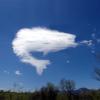We had an abrupt end of the summer too, with a front that dropped air temps 60F in 24hrs(!), and dumping 10" of snow. Ground is still warm so the snow didn't last. But my ponds had a lot of heat sucked out of them, dropping them into the 60's (core temps). Longer cooler nights are continuing their work so "Summer" won't be back, despite some day’s highs in the 80s. Tough to really mess with day length, sun angle, and water's ability to buffer heat gain and loss.
One thing I looked for following this early frigid front was within-day re-heating, as the sun is still high enough to offer some heating. This scenario is always stronger in the spring, but I watch for it in fall too. If I can find bass, prey, and good heating in a specific area, a “carnage zone” may erupt. And I did manage to find one this fall.
By mid-month the bass in my "Fall Transition Pond" for this year appear to be in binge mode already. Some years summer conditions can last into Sept. Not this one. But it appears we are only a week or a bit more ahead this year. The bass were just beginning to fatten up mid-month, being summer thin but with that little bulge in the mid-section that is a combo of developing gonads, mesenteric fat deposits, and food. This is not all that far off from "normal" years, I guess bc the mostly photoperiod-mediated endogenous rhythm kicks in at pretty much the same time every year. Most of my bass are pretty fat by early October. The fall feeding binge appears to me to be a combination of: heat loss (sun angle, day length), and dying vegetation that moves, exposes, and consolidates prey. In larger lakes, turnover may have a somewhat similar effect.
To find biters, I try to focus on prey types. The food my Sept bass have contained, or have been seen hunting, include gizzard shad, bluegills, and crayfish. One contained a partially digested mouse! No, I haven’t run out to buy any mouse lures.
My best catch rate in this fall’s pond, came by targeting crayfish-hunters, which isn’t easy bc of the amount of vegetation —little clean substrate. The rest of my fish have been… wherever I can find them. So I hear you on having to grind out a catch. Since I’m fishing small water there aren’t many places to run to, to either try to duplicate a “pattern” or find “fresh” fish. I was able to milk a few spots, but for only a fish at a time. My bass are happily feeding here, but as usual, lures are most often sorry replacement for “food”.
Presentations can be all over the place. I start with speed, usually in shallow cover, and then move out away-from-shore. I’ve found that sometimes speed is required in fall, and I mean burning. If the fish are so trigger-able, catches stack up fast. If this fails I slow down, but may re-try later in the day.
In many of my weedy ponds my focus tends to be the inside weedlines (shorelines), the outside weedlines (away-from-shore), and the flats in between. Sounds kind of obvious but each require different presentations. What matters is that the fish are there, and willing. One pattern that has held up over the... decades, is when weeds die back, turn brown and slimy, bass move to the outside edges of the beds or open pockets amongst, and respond best to a slower, often falling lure. My two favorites have been a swim-jig, fished in sweeps and falls, and a soft jerk on a lightly shank-weighted hook, that delivers a slow tantalizing fall that's a great trigger. This bait can actually do double duty, fished fast in darts or waking, or fished slow on the fall when paused.
The swim-jig also does double-duty by mimicing crayfish along the clean inside weed-edge, and then can be swum out onto the flat to mimic bluegills. Along the outer weedlines I also use a jig-worm or grub (Ned). I also like crankbaits here too, crawling them through cover edges like a jig.
Hope this helps. Don’t assume the worst. Still the same planet, for the time being anyway.


